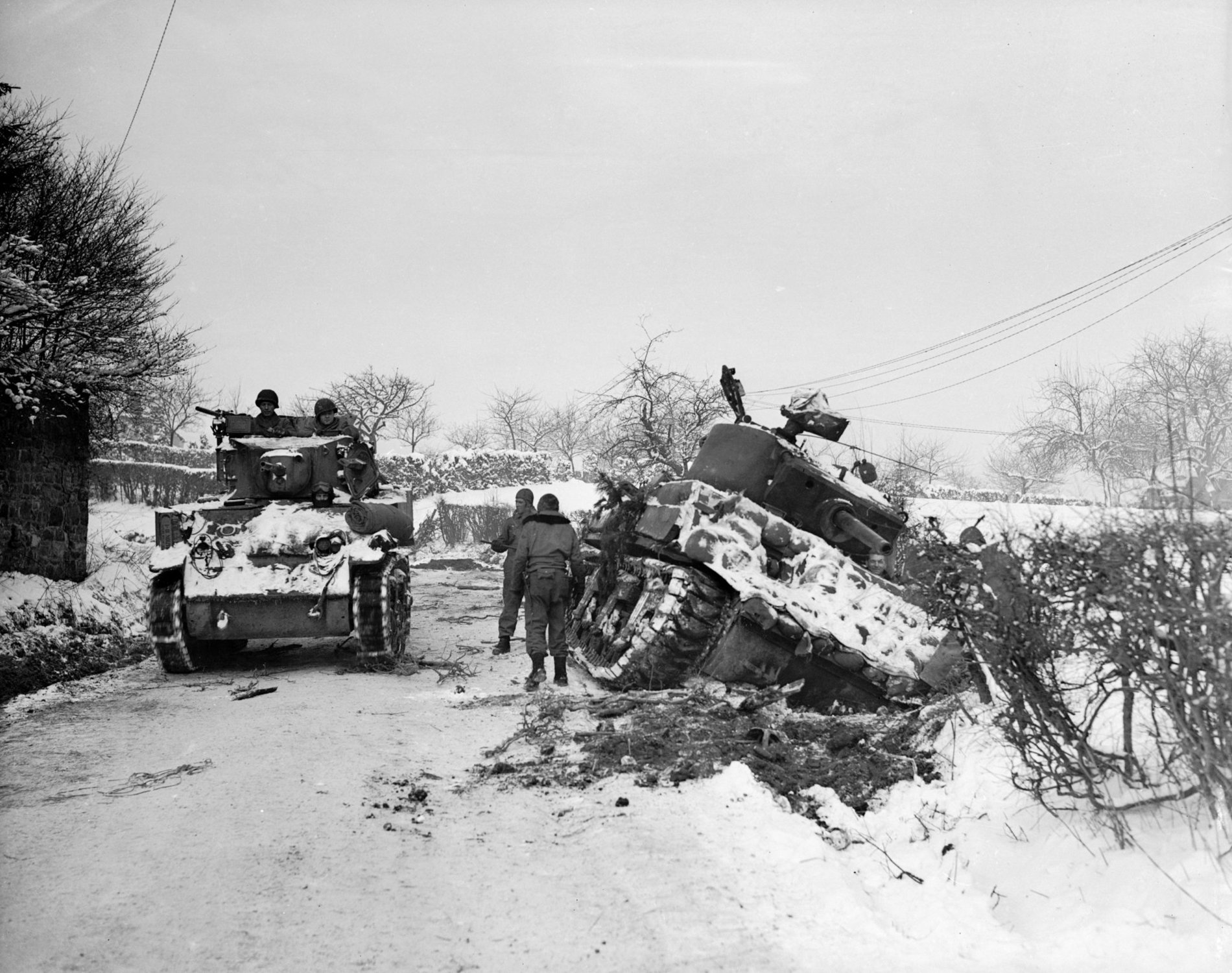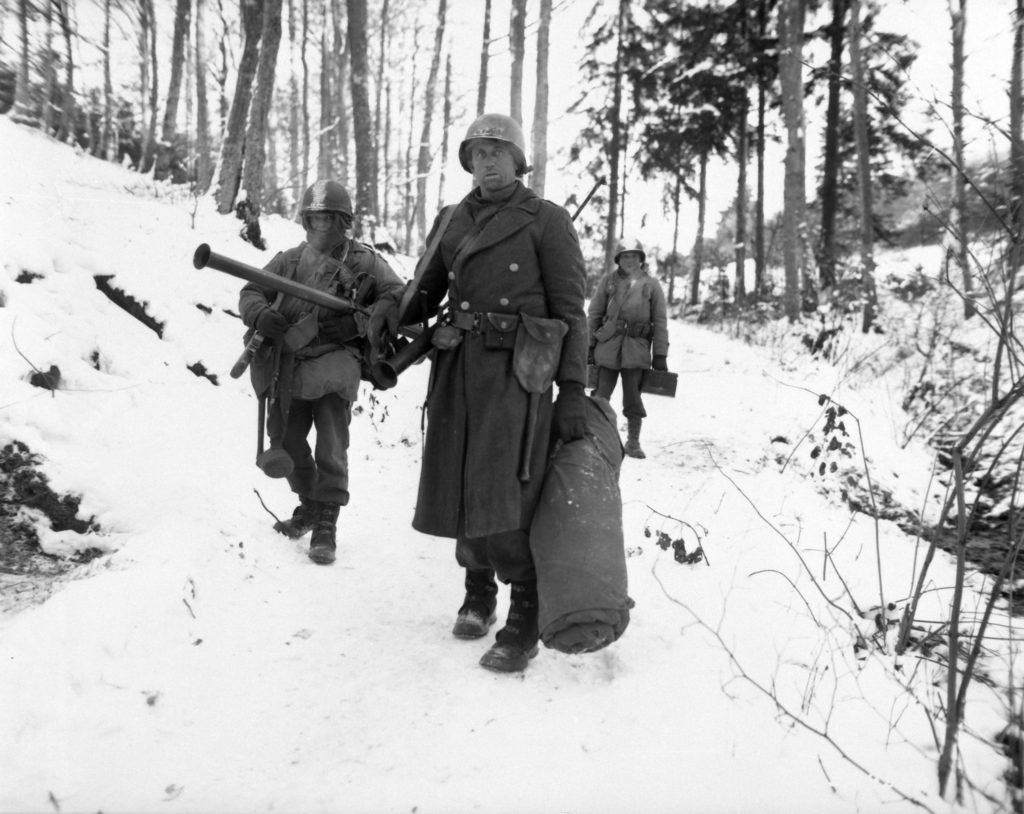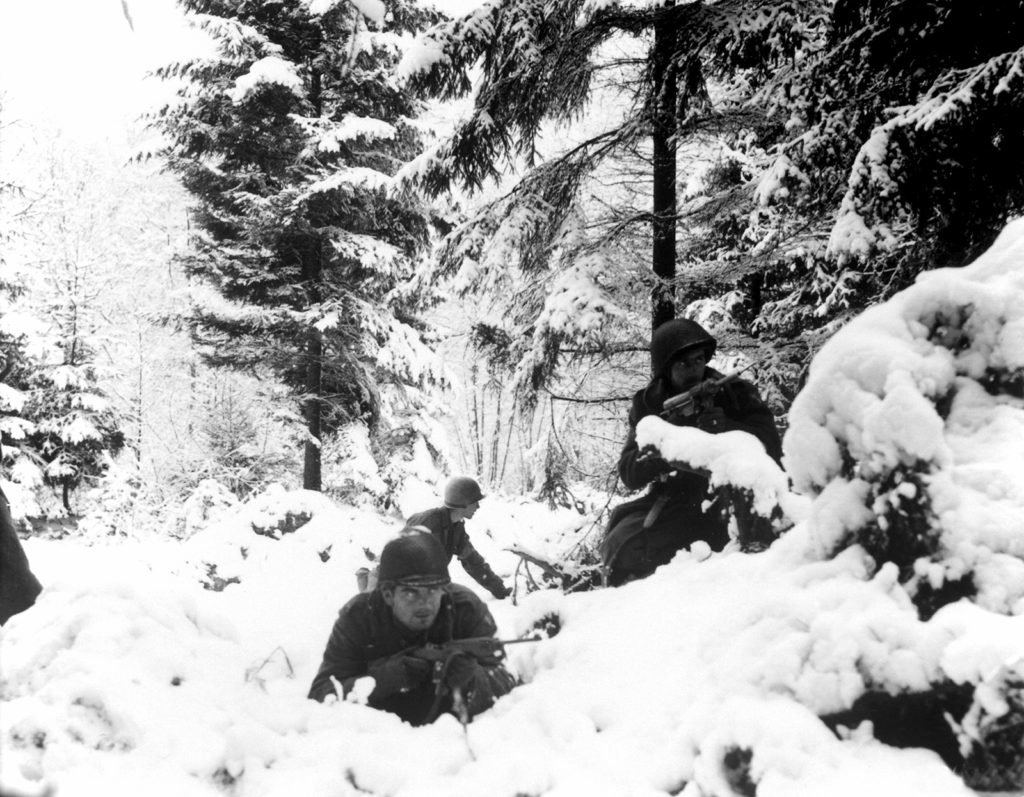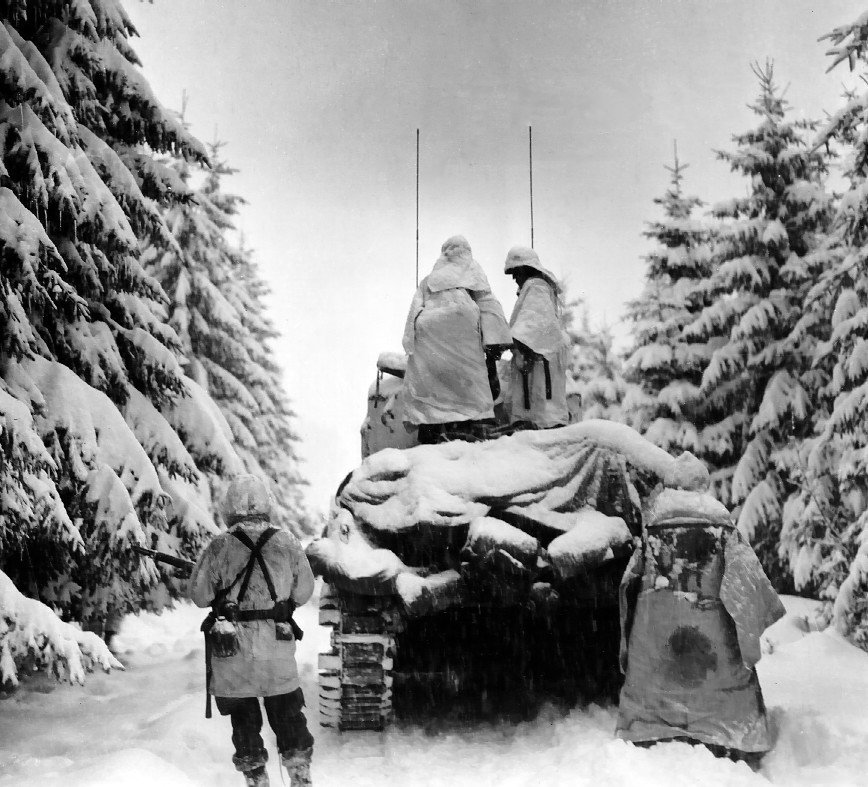Battle of the Bulge: Nazi Germany’s Final ‘Death Ride’ of World War II

January 1945: Hard going for US tanks at Amonines, Belgium, on the northern flank of the ‘battle of the bulge’. A tank on the road passes another being dug out of the snow. (Photo by Fred Ramage/Keystone/Getty Images)
When German shells began falling on American foxholes in the Ardennes on Dec. 16,1944, the Battle of the Bulge was underway. Allied forces had landed on the French coast in June (Normandy) and August (Provence), and from there pushed the Germans back to their borders along the Rhine River. The Battle of the Bulge — or Operation Wacht am Rhein in German — was slated to be Germany’s great counterstrike.
At the same time in the east, the Soviet colossus was on the Vistula River in Poland preparing for their drive on the Oder River, then on to Berlin. The most devastating war in history was coming to a close, but in the final act of the conflict, the long shadow of German history continued to influence modern military operations. But why did the Germans launch such an ambitious, 11th hour offensive through the Ardennes in the first place?
“The Prussian army always attacks.” Frederick II — or “Frederick the Great,” king of Prussia — is credited as saying this after his victory over the Austrians at Mollwitz in 1741. He followed this rule from Leuthen to Liegnitz. Sometimes it worked — but sometimes a doctrine of constant attack failed in spectacular fashion. Even after Frederick’s death, the idea of an army that never lets up the offensive pressure on an adversary persisted in Germany. Squeezed on two fronts in 1914? The Germans attacked, scoring a win over Russia at Tannenberg but losing to an Anglo-French army on the Marne.

Attacking France in the spring of 1940, German forces made an all-out (and high-risk) lunge for the English Channel, cutting off Allied forces in Belgium, and, after some hard fighting, securing French capitulation. In the fall of 1941, Guderian drove his panzers until they were in sight of the Kremlin. But with the exhausted German forces out of fuel, food, ammunition, and reserves, the subsequent Soviet counteroffensive sent German Army Group Center reeling.
The very next year, in a desperate attempt to seize Stalingrad, German 6th Army commander Friedrich Paulus spent everything he had. Unlike the fight around Moscow, German forces in the Stalingrad pocket were encircled, surrendering in early 1943.
The Prussian army always attacks.
Adolf Hitler agreed, writing in his book “Mein Kampf,” “strength lies not in defense, but in attack.” His actions during the war, hopping from offensive to offensive, demonstrated this. And in the Ardennes Forest in December 1944, the German army launched one of its last full-scale offensive strategies.

Again fitting with long-standing Prusso-German traditions, the German attack against a quiet sector in the American line was a death ride, or Totenritt. The term was born in 1870, at the Battle of Mars-la-Tour when Prussian cavalry General Fredrich Wilhelm von Bredow carried out a frontal assault on French artillery emplacements. He succeeded, at the cost of half of his men.
Dr. Robert Citino, executive director of the Institute for the Study of War and Democracy, wrote in his book, “The Wehrmacht’s Last Stand,” that “(t)he death ride was an order that a commander obeyed no matter how dim the prospects for success or what it was going to cost him or the men under his command. It existed in a realm beyond rational discourse or sober reflection.”
By the end of 1944, with Allied armies closing in, Hitler’s gamble in the Ardennes fits that category. The nominal German objective was the seizure of the vital port of Antwerp, but what then? The Western Allies had millions more men to throw into the struggle, as did the Soviets, whereas the Germans were down to drafting pensioners and boys.

So why did Hitler order Operation Wacht am Rhein to go ahead and strike American forces in Belgium? While the strict operational objectives (again, Antwerp) are well-known and documented, the psychology of the top Germans in 1944 is more opaque.
While it’s true that certain German staff officers protested the attack, they nevertheless obeyed their orders right to the end. (These were, naturally, the same officers who aided and abetted the most heinous crimes of the Nazi regime, and who later denied such crimes after the war.)
From long-standing Prussian traditions of remaining on the offensive and of fighting a lost fight to more practical concerns such as fear of Allied vengeance or even the tremendous bribes Hitler handed out to his senior officers, the German military ended 1944 with a catastrophic defeat in the west. American and British forces won the fight, of course, and destroyed much of Germany’s remaining offensive capacity in the process. Whatever the causes, the entire German nation rode a death ride through the end of the war, exacting an incalculable toll from all involved.
Interested in more reading on the topic? Robert Citino’s books are easy reads and exceptionally well researched. “The Wehrmacht’s Last Stand” covers the Battle of the Bulge in detail. Noted British historian Antony Beevor’s work “Ardennes: 1944“ is also worthwhile. For a more personal testament to the battle, try Dick Winters’ “Beyond Band of Brothers,” a moving account from a U.S. Army infantry officer’s perspective.

Garland Kennedy is a contributing writer for Coffee or Die. As an avid backpacker and outdoorsman, he has explored wide-open spaces all over North America — from the forests of North Carolina (he’s a graduate of UNC-Chapel Hill with a degree in medieval history) to the mountains of Alaska. His previous bylines include gear reviews on RockChuckSummit.com.
BRCC and Bad Moon Print Press team up for an exclusive, limited-edition T-shirt design!
BRCC partners with Team Room Design for an exclusive T-shirt release!
Thirty Seconds Out has partnered with BRCC for an exclusive shirt design invoking the God of Winter.
Lucas O'Hara of Grizzly Forge has teamed up with BRCC for a badass, exclusive Shirt Club T-shirt design featuring his most popular knife and tiomahawk.
Coffee or Die sits down with one of the graphic designers behind Black Rifle Coffee's signature look and vibe.
Biden will award the Medal of Honor to a Vietnam War Army helicopter pilot who risked his life to save a reconnaissance team from almost certain death.
Ever wonder how much Jack Mandaville would f*ck sh*t up if he went back in time? The American Revolution didn't even see him coming.
A nearly 200-year-old West Point time capsule that at first appeared to yield little more than dust contains hidden treasure, the US Military Academy said.












